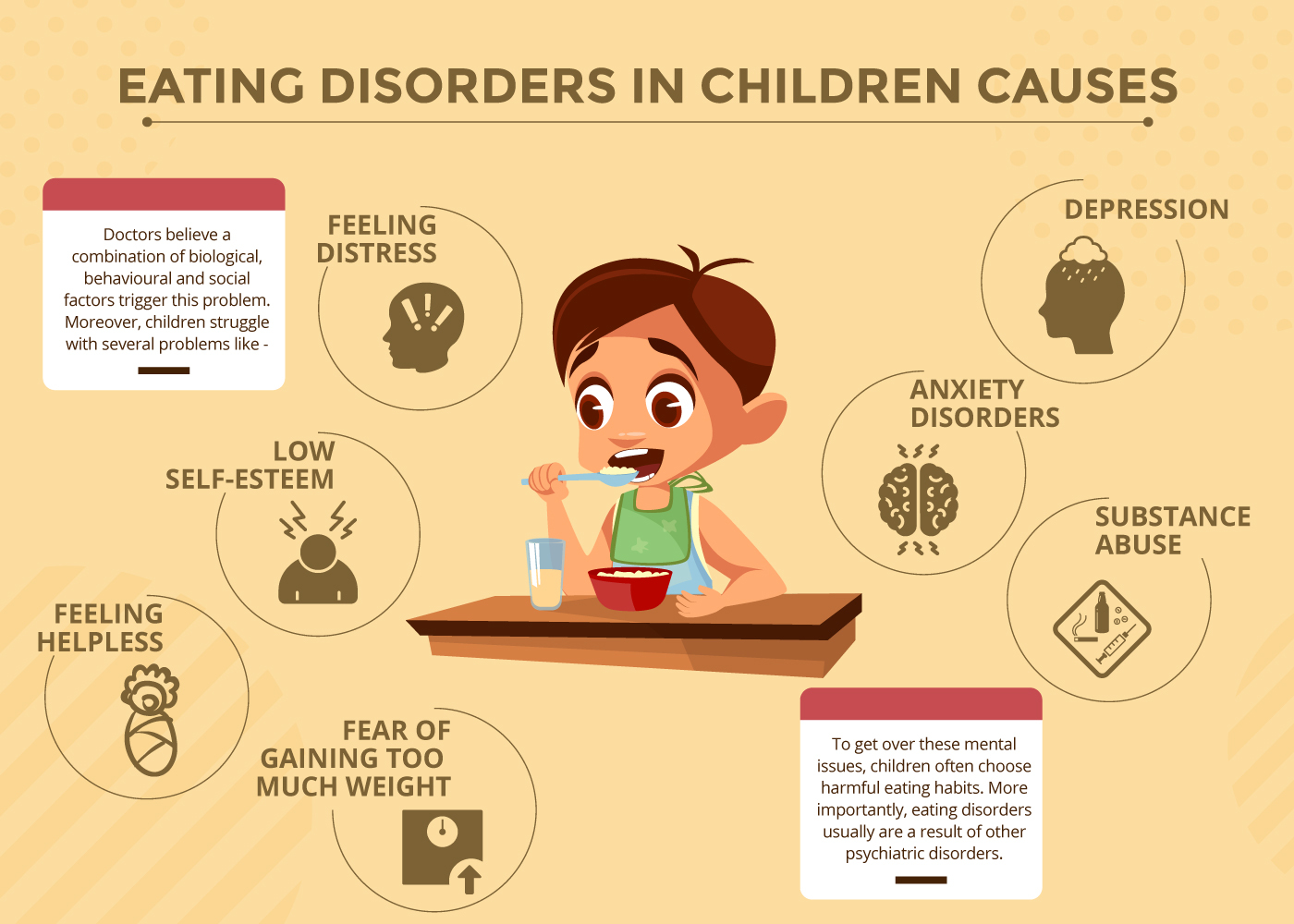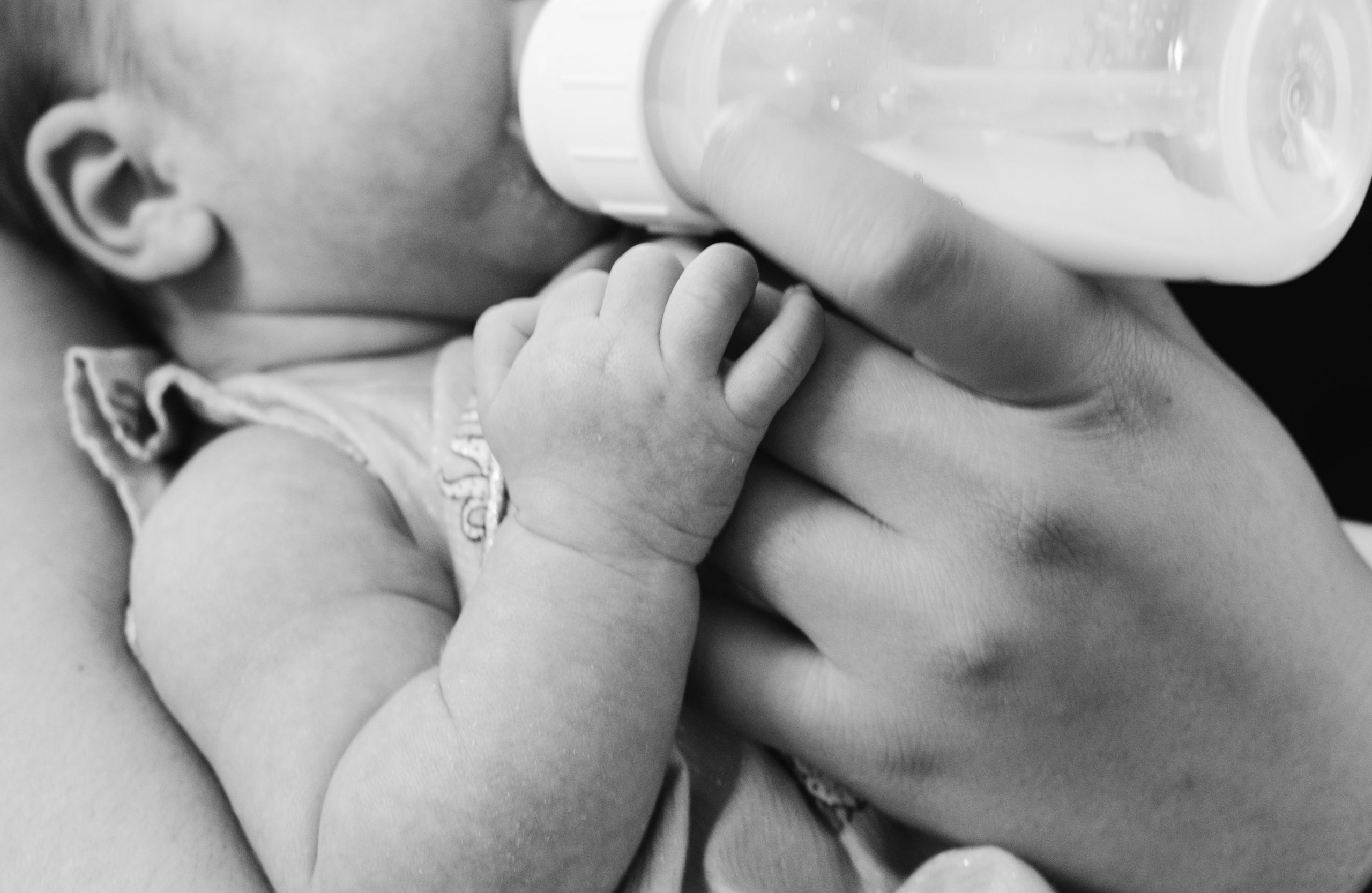Eating disorders in children and teens are serious conditions associated with eating habits. They can affect their overall health, emotions, and ability to work in particular areas of life. As a parent, the last thing you want is for eating to go from nutrition intake to crippling for your kids. Read on for all you need to know about the types of eating disorders in children.
Types Of Eating Disorders In Children
Mainly, there are three types of eating disorders in children –
- Anorexia – In this condition, a child doesn’t consume enough calories out of an intense and illogical fear of becoming fat.
- Bulimia – In this condition, the children indulge in gross binge eating, and later purge the food by vomiting or using laxatives hoping to prevent weight gain.
- Binge eating – In this condition, the children eat a lot of food, similar to bulimia, but do not purge.
Moreover, eating disorders can overlap in some children. For instance, a few children can have periods of anorexia and bulimia.
Generally, eating disorders develop during adolescence or early adulthood. However, these conditions can be observed during childhood too. Girls are more prone to developing these disorders. Only 5-15% of children with anorexia and bulimia are male, while with binge eating, the number rises to 35% male.
Causes Of Eating Disorders In Children

There is insufficient medical proof to figure out the main cause behind eating disorders, but doctors do believe that a combination of biological, behavioral, and social factors trigger this problem. For example, some children may be influenced by cultural images that favor thin or underweight bodies.
Moreover, children and adolescents with eating disorders struggle with several problems like –
- Feeling distressed
- Fear of gaining too much weight
- Feeling helpless
- Low self-esteem
To get over these mental issues, children often choose harmful eating habits. More importantly, eating disorders usually are a result of other psychiatric disorders like –
- Anxiety disorders
- Substance abuse
- Depression
Signs & Treatment Of Eating Disorders In Children
Eating disorders in children and teens may sound like a non-problematic issue, but they can even lead to death. You may believe that a child can overcome this problem with sheer willpower, but unfortunately, this is not possible.
The treatment of an eating disorder involves a doctor not just treating the disorder but also trying to address the underlying psychological issue. Early intervention is really required to get rid of eating disorders in children. Look out for these warning signs in your children to diagnose and treat the eating disorder they may suffer from –
Anorexia
This problem makes children and teens believe that they have a distorted body image. They consider themselves heavy even when they are dangerously thin.
As per the data of the National Institute of Mental Health, at least 1 in every 25 girls and women are going to suffer from anorexia at least once in their lifetime. However, most of them do not admit that they’re suffering from it. This can make treatment even more difficult.
The symptoms of Anorexia include – [1]
- Self-criticism, anxiety, perfectionism, or depression
- Dieting despite being thin
- Too much exercising
- Feared of being fat despite being thin
- Infrequent or no menstruation
- Quick weight loss
- Hiding weight loss with loose clothes
- Bizarre eating habits
- Unusual interests in food
Anorexia can also cause some serious health conditions, such as –
- Damaged body organs like the brain, kidneys, and heart
- Irregular heartbeat
- Low BP
- Decreased pulse rate, body temperature, and breathing rate
- Sensitivity to cold
- Bone thinning
The most common causes of death include cardiac arrest, suicide, and electrolyte imbalance.
Anorexia Treatment
The first line of treatment aims at bringing the child back to normal weight and eating habits. A few weeks of hospitalization may also be necessary. The doctors may have to use intravenous feeding in critical cases of life-threatening malnutrition.
The ways of treatments include –
- Antidepressant medication
- Behavioral therapy
- Psychotherapy
- Support groups
Bulimia
Similar to anorexia, bulimic children and teens also fear weight gain and are overly critical of their bodies.
Such children repeatedly eat too much food in quick succession and feel a loss of control. Subsequently, they feel ashamed and disgusted with their overeating. They then try to induce vomiting or use laxatives, diet pills, enemas, or diuretics to prevent weight gain. They feel relieved only after purging the food.
To diagnose bulimia, doctors have to watch the child for around three months and notice if he/she is having two or more episodes per week. Moreover, people with bulimia often stay within a normal weight range, despite being overweight.
Bulimia symptoms include [2]
- Drug and alcohol abuse
- Overusing laxatives, diet pills, and other treatments to avoid weight gain
- Anxiety
- Eating too much food frequently
- Having unusual eating habits
- Exercising a lot
- Repetitive mood swings
- Being too critical of physical appearance
- Staying for a long time in the bathroom after eating
- Being sad most of the time
- Scarring on knuckles suffered while inducing vomiting
- Vomiting after eating
It can also cause serious complications, such as –
- Damaged tooth enamel
- Esophagus inflammation
- Swelling of the salivary glands in the cheeks
Moreover, bulimia can also lower blood levels of potassium, which can lead to dangerously abnormal heart rhythms.
Bulimia Treatment
The first line of treatment aims at breaking the binge-and-purge cycle. So, the treatment may include –
- Antidepressant medication
- Behavior modifications
- Individual, family, or group therapy
- Nutritional counseling
Binge Eating Disorder
Binge eating disorder is very similar to bulimia since it also includes chronic, out-of-control eating, or consuming huge amounts of food in a quick time. This continues even if it causes discomfort. However, binge eaters do not purge the consumed food like bulimia patients. As a result, they become overweight or obese.
Moreover, binge eaters may also find it difficult to control their emotions; this worsens when they feel bad about eating too much and it leads to depression. Emotions like anger, stress, boredom, worry, or sadness may also lead to binge eating.
Binge eating may lead to the following serious health conditions in your child –
- Heart disease
- High BP
- High cholesterol
- Type 2 diabetes
Binge Eating Disorder Treatment
The treatment may include the following –
- Behavioral therapy
- Medications, including antidepressants
- Psychotherapy
Conclusion
Eating disorders in children can be life-threatening if you don’t recognize and treat them in time. Hence, it is very important to keep track of the eating habits of our children and get in touch with a pediatrician if any of the above-discussed symptoms appear. Moreover, the treatments and medications suggested above should never be self-administered, and have to be undertaken under the supervision of a doctor. The ImmunifyMe app can help you with a nutrition chart, so you have one less worry about your little one.
FAQs About Eating Disorders In Children
What Are Some Common Childhood Eating Disturbances?
Common childhood eating disorders or disturbances are anorexia, bulimia, and binge eating. There is no fixed cause of eating disorders, though it has been traced back to things like responding to stress or depression.
Why Do So Many Kids Have Eating Disorders?
Children have small bodies, with a smaller stature and lower weight. Food Fussiness or food refusal can lead to a small amount of weight loss. But because their bodies themselves are smaller, this can soon lead to eating disorders. Plus, children are more impressionable. If they begin to feel insecure about their weight, it can manifest in the form of an eating disorder.
What Are The Names Of Eating Disorders?
Some eating disorders are Anorexia Nervosa, Binge Eating Disorder, Other Specified Feeding and Eating Disorders (OSFED), Bulimia, Avoidant Restrictive Food Intake Disorder (ARFID), Rumination Disorder and Unspecified Feeding or Eating Disorder (UFED).
Is It Possible For A 4 Year Old To Have An Eating Disorder?
A 4-year-old with a full-fledged eating disorder is rare. However, it could start to develop from this age. Keep an eye out for your child having fear or aversion to stomach aches, and saying things about their weight or body. The seeds of insecurity can be sown early, and it’s this that can lead to eating disorders as they grow old.
References –
[1] – Behavioral activation and lack of concern, core symptoms of anorexia nervosa? [2] – Bulimia – Symptoms and Syndromes in an Urban Population






